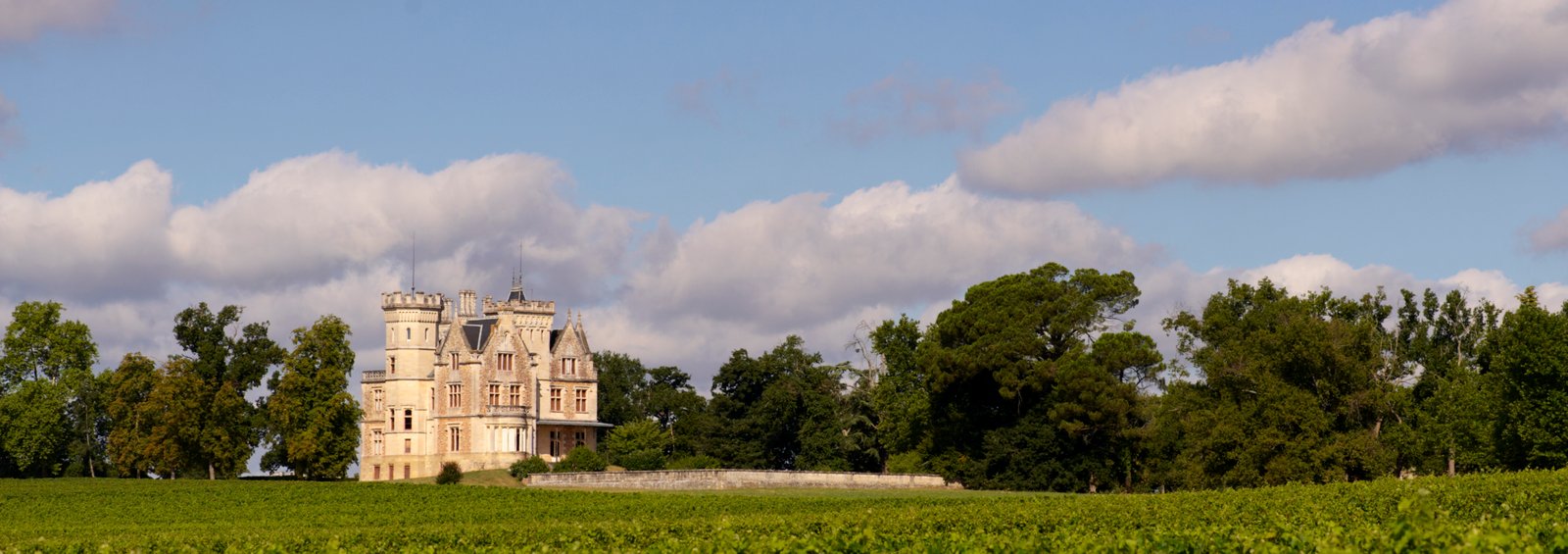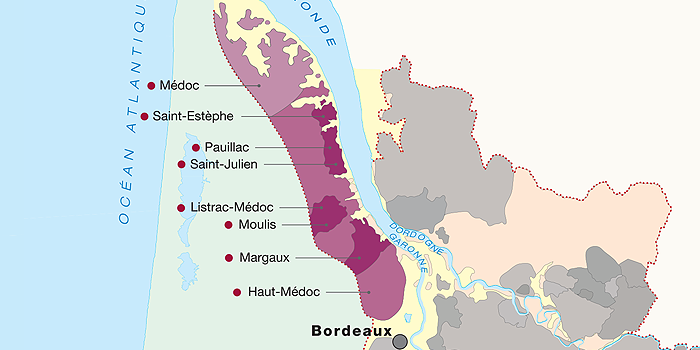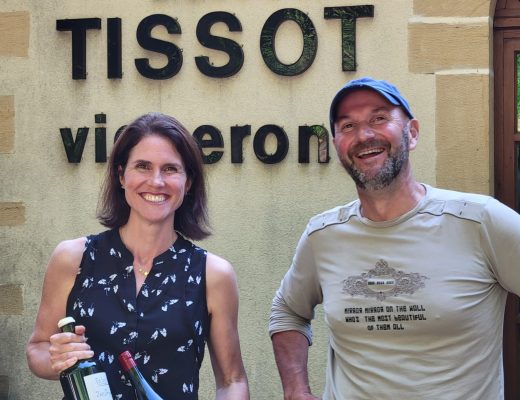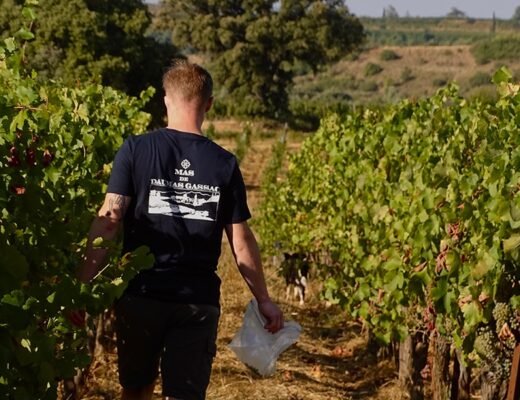Photo credit: Philippe Caumes
The Médoc region of Bordeaux is famous for its cru classés châteaux and its refined, ageworthy Cabernet-Sauvignon, Merlot blends. However, wines from the Médoc can also be incredibly affordable, offering great value for every day consumption.
Médoc Geography
The Médoc region is located north of Bordeaux, on the left bank of the Gironde estuary. Over 16,000 hectares of vineyards are planted here, spread over eight appellations. Heading north from the city of Bordeaux, these are: Haut-Médoc, Margaux, Moulis-en-Médoc, Listrac-Médoc, Saint-Julien, Pauillac, Saint-Estèphe, and Médoc.
The Médoc region has a warm, maritime climate. Sandwiched between the Atlantic ocean and the Gironde estuary, the Médoc peninsula benefits from the temperature moderating effect and the air circulation provided by these two large bodies of water. While spring and early summer can be fairly damp, dryer conditions later in the growing season allow for full and consistent ripening most vintages.
The soils of the Médoc are diverse in nature. In the south-east, gravel-rich soils are most prevalent. These gravels, mixed with sand and other alluvial deposits, originate from two sources: the Massif Central and Pyrenees mountains. They were carried along the Dordogne and Garonne rivers respectively, over thousands of years. Gravel is prized for its ability to warm quickly in the spring, reflect heat up into the vines during the day, and radiate it at night, aiding with ripening. It is also free draining, encouraging deep vine rooting. Late ripening grapes like Cabernet Sauvignon and Petit Verdot are most planted in the gravelly soils of the Médoc.
In lower lying areas, and notably, as you move further north and west, heavier clay-limestone soils, often with quite stony surface layers, dominate. These cooler, water retaining soils are common in large swathes of the Médoc AOC, as well as the appellations of Moulis, Listrac and Saint-Estèphe. Early to mid ripening grapes like Merlot and Cabernet Franc thrive in these clay-based areas, yielding fruity, fleshy wines that round out the often angular Cabernet Sauvignon.
For an excellent 3D ariel view of the Médoc vineyards, click here.
Photo credit: Conseil interprofessionnel du vin de bordeaux
Quality Classifications
Two quality hierarchies exist for wines from the Médoc. The most famous, the 1855 classification, ranks top châteaux in five tiers from Premier Grand Cru Classé (first growths) to Cinquième Grand Cru Classé (fifth growths). With few exceptions, this ranking has remained unchanged since its inception. To learn more about the history and debate surrounding the 1855 classification, listen to my audio overview here.
A second estate classification system, Cru Bourgeois, was established in 1932 to highlight high-quality wines from the Médoc not included in the original list. This ranking has had quite a tumultuous history, with numerous revisions, an annulment, and much debate. The latest update was finalized as recently as February of this year. The 2020 Cru Bourgeois classification includes 249 châteaux ranked in three categories: Cru Bourgeois, Cru Bourgeois Supérieurs, Cru Bourgeois Exceptionnels. The ranking is set to be revised every five years, and all estates up for consideration must hold the French agricultural sustainability certification: Haute Valeur Environnementale.
Earlier this month I tuned in to a virtual seminar on wines from the Médoc, which gave an overview of each of the appellations and highlighted one wine from the area.
MÉDOC AOC
The region-wide Médoc AOC can be used for any wine produced within the Médoc production area. For example, producers in Margaux or Saint-Julien may choose to declassify to Médoc AOC, potentially for young vines or areas of the vineyard yielding less ripe or pristine fruit. However, this practice is not frequently seen.
The appellation is generally reserved for the designated Médoc AOC section of vineyards that covers the northern third of the Médoc peninsula. This large area has 5,560 hectares of vines planted on mixed gravel and clay-limestone soils. Wine styles vary widely, depending on site and producer, but tend to be fashioned in a light, early-drinking, approachable style, with minimal oak ageing.
Merlot is the dominant grape here, and tends to make up the lion’s share of blends. Wines from the Médoc AOC are notably good value in warmer vintages, where grapes ripen fully, yielding wines with greater concentration, and more vibrant fruit flavours. Recent such vintages include 2015, 2016, 2018.
Château Tour St. Bonnet Médoc 2015 – 87pts. PW
The 2015 Château Tour St. Bonnet is a blend of 65% Merlot, 30% Cabernet Sauvignon, 5% Petit Verdot. It is vinified in concrete tanks and aged for 18 months in the same vessel. The hot, sunny 2015 growing conditions are apparent in the ripe red fruited nose, the smooth, supple structure, and velvety tannins. Fairly linear and short on the finish, but overall a pleasant, every day Bordeaux with attractive savoury undertones.
Where to Buy: SAQ ($23.85)
LISTRAC-MÉDOC
Listrac-Médoc neighbours Moulis-en-Médoc to the north. It boasts a marginally higher elevation than surrounding vineyards, reaching 43 metres at its highest point. Small in Médoc terms, with just 787 hectares of vines, Listrac-Médoc represents 5% of the Médoc vineyard area. The soils composition consists of three Pyrenean gravel terraces to the west, a Garonne gravel outcrop to the east, and a large central, flat land of clay-limestone.
This more marginal vineyard area is buffeted by strong winds and thus tends to ripen quite slowly. In warm vintages, this slow rate of berry maturation is an advantage, allowing for good acid retention and full phenolic development. However, in cooler growing seasons, Listrac-Médoc wines can be quite lean and vegetal.
Château Vieux Moulin Listrac-Médoc 2016 (Cru Bourgeois) – 88pts. PW
A blend of 58% Merlot, 35% Cabernet Sauvignon and 7% Petit Verdot, the Château Vieux Moulin 2016 is aged for 12 months in, mainly seasoned, French oak barrels. Restrained aromas of dark fruit, tobacco leaf, and hints of bell pepper on the nose. Brisk acidity on the attack, followed by a moderately firm, somewhat angular palate, with moderate concentration of tangy red and black fruit, with underlying dried herbal notes. Attractive chalky tannins frame the finish.
Moulis-en-Médoc
This narrow strip of vineyard land lies just north of Margaux, touching Listrac-Médoc. It is the smallest appellation of the Médoc, with 610 hectares planted, and 46 wine producers. The western part of the region is a fairly flat expanse with mainly sandy-clay soils. The central area features gravelly top soils with underlying clay-limestone layers. In the easternmost vineyards, closest to Margaux’s northern border, outcrops of Garonne gravels are highly prized vineyard soils.
Quality is variable depending on producer and vineyard site. Neither Moulis-en-Médoc nor Listrac-Médoc contain classed growth châteaux, however both have reputed Cru Bourgeois estates. Some famous names in Moulis-en-Médoc include Château Chasse-Spleen, Château Poujeaux, and Château Garricq.
Château La Garricq Moulis-en-Médoc 2015 (Cru Bourgeois) – 90pts. PW
This blend of 50% Cabernet Sauvignon, 30% Merlot and 20% Petit Verdot is aged for 12 months in 1/3 new French oak. This is evident from the spicy, cedar notes on the nose, mingled with black fruit, dark chocolate, and hints of graphite. The palate shows more harmonious oak integration, with its concentrated red and black fruit flavours, tangy acidity, broad structure, and plush texture. Firm, ripe tannins frame the finish nicely.
Where to Buy: SAQ ($34.75)
HAUT-MÉDOC
The Haut-Medoc appellation stretches some 60 kilometres in length from just north of the city of Bordeaux, to north west of Saint-Estèphe. Due to its size, and diversity of soil types, orientations, aspects, proximity or distance from the Gironde, and so forth, wine style and quality from the Haut-Médoc is incredibly varied.
For much of its history, the Haut-Médoc, as well as the appellations along its north-south expanse, were salt marshes, unusable for viticulture. In the 17th century, Dutch merchants drained the marshes to expand Bordeaux vineyard acreage.
The majority of the Médoc’s Cru Bourgeois Supérieurs and Exceptionnels estates, as well as five cru classé châteaux are located in the Haut-Médoc.
Château de Gironville Haut-Médoc 2016 (Cru Bourgeois) – 91pts. PW
Château de Gironville is situated in the commune of Macau, just south of Margaux, near the mouth of the Garonne River. The estate boasts deep, fine gravel soils on their Cru Bourgeois ranked property. This blend of equal parts Merlot and Cabernet Sauvignon is completed with 10% Petit Verdot. According to estate director, Yannick Reyrel, the Petit Verdot gives an intriguing peppery, fruity nuance to the blend and the gravel soils bring a suave texture.
Initally closed. High toned plum, cassis, and dark cherry aromas emerged with aeration, underscored by complexifying notes of black licorice, nutmeg, and earth. Fresh, full-bodied, and stylish on the palate with lively dark fruit flavours, ripe, polished tannins, and a lengthy finish. Drinking well now, with 4 – 5 years ageing potential.
Where to Buy: SAQ ($30.00, $62.00 for magnums)
SAINT-ESTÈPHE
Saint Estèphe is the northermost and largest of the cru appellations within the Haut-Médoc. The region’s 1,229 hectares of vineyards are spread across an undulating landscape, with gentle hillsides reaching 20 metres at their highest point. While gravel-rich soils are prevalent, notably at higher elevations, Saint Estèphe has significant areas of clay-dominant soils, with a limestone bedrock. Greater concentrations of clay in Saint-Estèphe equate to wider plantings of Merlot, giving the bold, full-bodied wines of the area a certain mid-palate roundness.
Saint Estèphe has a mere five cru classé estates. However its best properties, including second growths, Château Cos d’Estournel and Château Montrose, and third growth, Château Calon-Ségur, are highly esteemed.
Château Beau-Site St. Estèphe 2015 (Cru Bourgeois) – 92pts. PW
Château Beau-Site overlooks the Garonne River, from one of Saint-Estèphe’s higher grounds. The stony soils of the estate are deep and free-draining. The 2015 vintage is a blend of 70% Cabernet Sauvignon, 25% Merlot, 3% Petit Verdot and 2% Cabernet Franc, aged 18 months in 35% new French oak. Intense aromas of prune, mocha, and pencil shavings, are lifted by underlying hints of menthol and red currant. The palate is remarkably fresh, given the hot summer, with concentrated flavours of dark chocolate, black fruit, menthol, and cedar, and a dense, weighty structure. Excellent length and balance. Drinking well now.
Where to Buy: SAQ ($43.75)
MARGAUX
Margaux is the southernmost of the Haut-Médoc cru appellations, situated near the confluence of the Garonne and Gironde rivers. Vast quantities of Garonne gravel cover Margaux’s central area. This nutrient-poor soil has excellent drainage stimulating deep vine rooting. Margaux has a marginally warmer mesoclimate than surrounding areas. The wines of the area are often described as quite velvety in texture with floral overtones and exotic spice nuances.
With its 1500 hectares of vines, Margaux accounts for 9% of the Médoc region’s vineyards. Among its 65 producers, Margaux has a whopping 21 classed growth châteaux – more than any other Médoc appellation. The region also boasts a number of highly regarded Cru Bourgeois estates.
Château d’Arsac Margaux 2014 (Cru Bourgeois Exceptionnel) – 89pts. PW
Château d’Arsac is a well-regarded 112-hectare property in the western part of the appellation. This blend of 53% Cabernet Sauvignon and 47% Merlot is reflective of the cooler 2014 vintage with its restrained bell pepper, dried herbal, and tart red currant aromas. The palate is far more inviting, with brisk acidity nicely balancing a broad, textural mid-palate and moderate concentration of dark fruit, graphite, and herbal flavours. Overall, a pleasant, supple wine – yet lacking the depth and opulence of top Margaux.
Where to Buy: SAQ ($38.50)
SAINT-JULIEN
Bordering the Gironde, just south of Pauillac, lies Saint-Julien. The 910 hectares of the appellation are planted on fairly uniform, gravel-rich soils. This factor is given as an explanation for the impressive concentration of classed growth estates here. Indeed, of a total 19 wine producers in Saint-Julien, 11 were included in the 1855 classification. There are no first growth vineyards in Saint-Julien, but its second growths are often referred to as “super seconds” inferring that they are worthy of first growth status. These include: Château Ducru-Beaucaillou, Chateau Gruaud-Larose, Léoville-Las Cases, Léoville-Barton, and Léoville-Poyferré.
The wines of Saint-Julien are often described as a combination of the silkiness and floral elegance of Margaux, with Pauillac’s power and heft.
Sarget de Gruaud Larose St. Julien 2016 – 94pts. LW
Sarget is the second label from Château Gruaud Larose. The 2016 cuvée is made from 59% Cabernet Sauvignon, 31% Merlot, 6% Cabernet Franc, and 4% Petit Verdot. Fragrant aromas of black plum, raspberry, violets, and exotic spice feature on the highly complex nose. The palate is full-bodied and firm, with a highly concentrated core of tangy red and black fruit, savoury notes, and subtle cedar nuances. Very polished and precise overall, with fine-grained tannins and a lengthy finish. Drinking well now, but should improve over the next eight to ten years.
Where to Buy: SAQ ($54.00)
PAUILLAC
The vineyard region of Pauillac is named for the Gironde port town of the same name. Cabernet Sauvignon dominates on the region’s gravel rich soils. However, marked variations in the depth, origin, and concentration of gravels across higher and lower lying sites leads to significant quality differences. In general terms, the wines of Pauillac are considered the most muscular and long lived of the Médoc, with notable cassis and graphite aromas.
Pauillac is the only Haut-Médoc cru appellation with two first growth estates: Château Lafite Rothschild and Château Mouton Rothschild. In all, Pauillac consists of 1213 hectares of vines, and has 18 classed growth estates.
Lacoste-Borie Pauillac 2016 – 93pts. LW
This is the second wine from fifth growth, Château Grand Puy Lacoste. The 2016 blend features 61% Cabernet Sauvignon, 29% Merlot and 10% Cabernet Franc, aged in 45% new French oak for 15 months. Classic Pauillac aromas of cassis, dark plum, graphite, cedar, and hints of earthy, black truffle feature on the attractive, highly complex nose. The palate is lively, with a dense, full-bodied structure, and excellent depth of savoury, dark fruited flavours. Well-knit cedar nuances and firm, quite muscular tannins mark the finish. Would show best with six to eight years further cellaring, though has the power to hold nicely for another decade.
Where to Buy: SAQ ($59.00)
*** What do VW, PW and LW mean? Click on my wine scoring system to find out.







No Comments